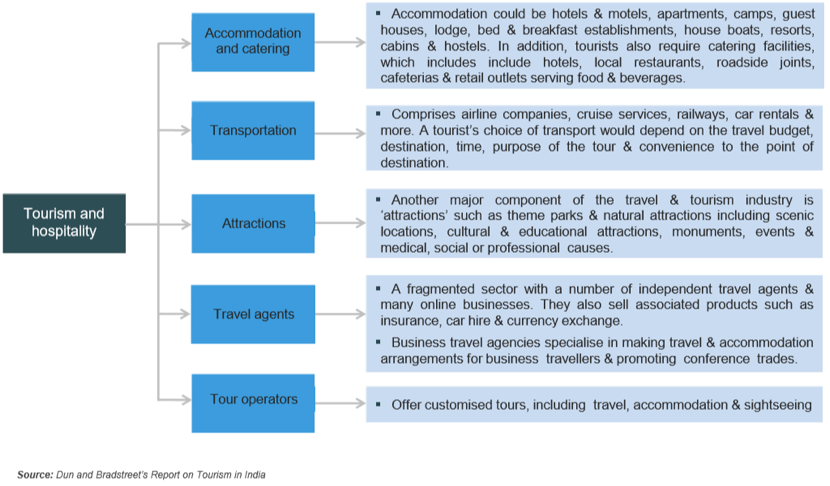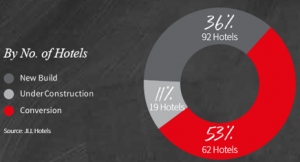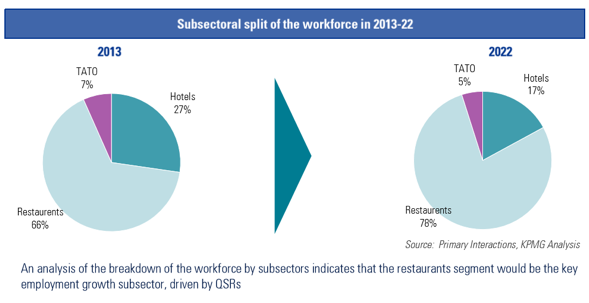Good to have you back for our blog series on ‘The Service sector – opportunities in the challenges’.
India’s services sector GVA grew at a CAGR of 6.93% to US$ 1,266.1 billion in FY18 from US$ 846.8 billion in FY12. (India Brand Equity Foundation). What are the in-demand skills needed by the next generation of workers in the service sector and is there an opportunity for VET and apprenticeships to fill the skill gap?
In Parts I & II we looked at vocational skills-based employment opportunities in Retail & E-commerce and Beauty & Wellness. This week in Part III, we examine the potential of Tourism & Hospitality to up job creation for the vocationally skilled. Our next sector analysis in Part IV will be Logistics.
Tourism & Hospitality
In 2016 the travel and tourism sector in India accounted for 9.3% of total employment opportunities generated that year, providing employment to around 40.3 million the same year. The number is expected to rise by 2% annually to 46.42 million jobs by 2026 [i].
The travel and tourism industry attracts a young workforce and is heavily dependent on ‘people skills’ or soft skills such as customer service, front office staff and tour guides, to name a few. Other in-demand skills are F&B, housekeeping, ticketing and sales. The Ministry of Tourism has a target to train 5 million people by 2022. Programmes, such as Hunar Se Rozgar Tak trained over 250,000 people in 2016 [ii]. In recognition of the potential of the north-eastern states of India to provide skilled hospitality & tourism staff, 12 Institutes of hospitality management were sanctioned in the region in August 2016 [ii].These are some of the steps being taken to ramp up employment in this sector. However, given the enormous human capital requirement, this sector seeks a massive scaling up of skill training is needed.
The Indian travel and hospitality sector can be divided into sub-segments such as cruises, adventure, medical, wellness, sports, eco-tourism, film, rural and religious tourism.
The following chart is indicative of the potential for job creation of various roles across different services.


Skilling for Hotels
Hotels as a sub-sector are expected to grow at 11.88% in FY18 [i]. According to realty research firm JLL, the past two years have closely mirrored each other with renewed vibes in this segment where deals amounting to 173 hotels or 16,020 rooms, and 170 hotels were signed respectively in 2017 and 2016 [ii].




An interesting revelation at the September 2018 ET CEO Roundtable by Ritesh Agarwal, Founder, OYO Rooms, which has a presence in 160 Indian cities, was that two-thirds of their business is generated from smaller cities. There has also been a surge in weekend leisure travel from non-metro cities which has contributed to 40% of his company’s revenues, up from 10% three years ago. We are able to gauge from such insights that there is a steadily growing appetite for travel and leisure services and consumables in non-metro cities, which have largely been an untapped market both for the travel industry and for suitably skilled hospitality staff across job levels. Ritesh Agarwal further sums up the potential as, “For every 3 rooms we open, a new job gets created. And we continue doing more and more of that – I think we can only have skilled-based employment.”
International hotel chains are expected to play a dominant role too accounting for around 47% share in the tourism & hospitality sector of India by 2020 and 50% by 2022 [iii].
To further boost the development of hotels the government has allowed a 5-year tax grace for 2,3 and 4-star category hotels located around UNESCO World Heritage sites (except Delhi & Mumbai) [ii]. This sentiment is echoed by the Make in India initiative which allows 100% FDI in tourism construction projects, including the development of hotels and resorts. Also, @MSDESkillIndia has set up a Tourism and Hospitality Skill Council (THSC), to look into specific skills for the sector. THSC has launched a digital platform “Skill Grid” to connect hotels and tourism service providers to training partners and candidates who have completed or currently undergoing training in hospitality and tourism skills.
Overall, a conducive eco-system within the sector have contributed to high employment growth potential in this sector. Other key factors driving this are:
- Expected rise in domestic brand awareness globally due to 49% FDI in aviation allowing foreign companies to team up with domestic airline brands [v].
- With increased internet penetration and online travel services the online consumer base is expected to surge
- Growth in e-visas including medical tourism visas
A key sub-segment of hospitality is restaurants which have witnessed a strong growth especially at the back of online food delivery consumerism and digital payment options. This has led to a huge demand for 3 PL services, delivery and customer care executives, food packaging, temperature controlled storage and delivery capabilities.


Foreign Tourism Readiness
Moving on to inbound foreign tourism, foreign tourist arrival figures showed an increase of 13.4% in March 2018 from a year before [vi]. India’s international arrivals are forecast to reach 15.3 million by 2025, according to the World Tourism Organisation. The period between January-March 2018, a total of 7.62 lakh tourists arrived on an e-tourist visa registering a growth of 63% from the same period in 2017 [vi]. The Visa on Arrival scheme currently applies to 150 countries [ii].
On the global Tourism Competitiveness Index, India was placed 40 in 2017 compared to 65 in 2013. The Ministry of Tourism attributes this to improved infrastructure in the country along with the introduction of niche religious circuit schemes such as the Swadesh Darshan which has 67 projects underway. This indicates an increased demand for knowledgeable workers, for instance, tour guides. However, in the absence of specific data, it is unclear whether these growth figures in foreign tourists translate into sizeable job creation.
Tourism and hospitality present a tremendous opportunity to upskill and provide jobs for millions of youth. One would hope that along with increased investment in infrastructure and technology this sector will directly impact job creation from the bottom of the skill pyramid where human capital skilling need is the highest.
If you have missed any of our previous posts in our blog series ‘Why the Service Sector Matters for Vocational Training and Apprenticeships in India’, do go back and have a look at the opportunities for vocational skills in Retail & E-commerce and Beauty & Wellness.
Next week we will be delving into the changing and exciting Logistics sector.
To continue to follow new posts in this series and more, Sign up to our weekly newsletter to receive all the latest views, news, research and articles on apprenticeships. You can also register to contribute your opinion on this forum.
References
i. IBEF Tourism & Hospitality, January 2018.
ii. Incredible India 2.0 India’s $20 Billion Tourism Opportunity, 2017
iii. Services Sector in India, June 2018, India Brand Equity Foundation
iv. Ready Steady Go-India Hospitality Industry Review 2017, JLL
v. Human Resource and Skill Requirements in Travel, Tourism and Hospitality, Executive Summary, National Skill Development Corporation- KPMG
vi. Press Information Bureau, Apr 13, 2018, Ministry of Tourism, GoI
















